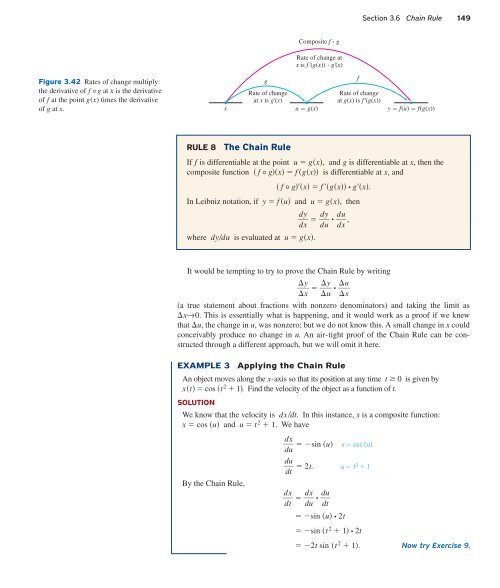5128_Ch03_pp098-184
You also want an ePaper? Increase the reach of your titles
YUMPU automatically turns print PDFs into web optimized ePapers that Google loves.
Section 3.6 Chain Rule 149<br />
Composite f ˚ g<br />
Rate of change at<br />
x is f'(g(x)) • g'(x)<br />
Figure 3.42 Rates of change multiply:<br />
the derivative of f g at x is the derivative<br />
of f at the point gx) times the derivative<br />
of g at x.<br />
x<br />
g<br />
Rate of change<br />
at x is g'(x)<br />
u g(x)<br />
f<br />
Rate of change<br />
at g(x) is f'(g(x))<br />
y f(u) f(g(x))<br />
RULE 8<br />
The Chain Rule<br />
If f is differentiable at the point u gx, and g is differentiable at x, then the<br />
composite function f gx f gx is differentiable at x, and<br />
f gx f gx • gx.<br />
In Leibniz notation, if y f u and u gx, then<br />
d y dy<br />
• d u<br />
,<br />
dx<br />
d u dx<br />
where dydu is evaluated at u gx.<br />
It would be tempting to try to prove the Chain Rule by writing<br />
y <br />
<br />
x<br />
y<br />
u<br />
• u<br />
<br />
x<br />
(a true statement about fractions with nonzero denominators) and taking the limit as<br />
x→0. This is essentially what is happening, and it would work as a proof if we knew<br />
that Du, the change in u, was nonzero; but we do not know this. A small change in x could<br />
conceivably produce no change in u. An air-tight proof of the Chain Rule can be constructed<br />
through a different approach, but we will omit it here.<br />
EXAMPLE 3<br />
Applying the Chain Rule<br />
An object moves along the x-axis so that its position at any time t 0 is given by<br />
xt cos t 2 1. Find the velocity of the object as a function of t.<br />
SOLUTION<br />
We know that the velocity is dxdt. In this instance, x is a composite function:<br />
x cos u and u t 2 1. We have<br />
By the Chain Rule,<br />
dx<br />
sin u<br />
d u<br />
x cos (u)<br />
d u<br />
2t.<br />
dt<br />
u t 2 1<br />
d x dx<br />
• d u<br />
<br />
dt<br />
d u dt<br />
sin u • 2t<br />
sin t 2 1 • 2t<br />
2t sin t 2 1. Now try Exercise 9.












